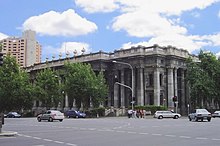Parliament of South Australia | |
|---|---|
| 55th Parliament | |
 | |
 Parliament of South Australia logo | |
| Type | |
| Type | |
| Houses | Legislative Council House of Assembly |
| Sovereign | Governor of South Australia (the representative of the King)[a] |
| History | |
| Founded | 22 April 1857 |
| Leadership | |
Frances Adamson since 7 October 2021 | |
| Structure | |
| Seats | 69 47 MHAs 22 MLCs |
 | |
House of Assembly political groups | Government (27)
Labor (27)
Opposition (13) Liberal (13)
Crossbench (6) Independent (6) [b], with Cregan serving in the Cabinet) |
 | |
Legislative Council political groups | Government (9)
Labor (9)
Opposition (8) Liberal (8)
Crossbench (5) Greens (2)
|
Length of term | House: 4 years Council: 8 years |
| Elections | |
| Instant-runoff voting | |
| Single transferable vote | |
First general election | 21 February 1851 as unicameral Legislative Council 9 March 1857 as bicameral parliament |
Last general election | 19 March 2022 |
Next general election | 21 March 2026 |
| Redistricting | Redistributions are carried out after each election by the South Australian Electoral Districts Boundaries Commission. |
| Meeting place | |
 | |
| Parliament House, Adelaide, South Australia, Australia | |
| Website | |
| www | |
| Constitution | |
| Constitution of South Australia | |
The Parliament of South Australia is the bicameral legislature of the Australian state of South Australia. It consists of the 47-seat House of Assembly (lower house) and the 22-seat Legislative Council (upper house).[2] General elections are held every 4 years, with all of the lower house and half of the upper house filled at each election. It follows a Westminster system of parliamentary government with the executive branch required to both sit in parliament and hold the confidence of the House of Assembly. The parliament is based at Parliament House on North Terrace in the state capital of Adelaide.
Unlike the federal parliament and the parliaments of most other states, the South Australian Constitution does not define the parliament as including either the monarch or the governor of South Australia as one of its constituent parts. However, the constitution also vests legislative power in the state's governor acting with the advice and consent of both houses of parliament,[3] making the role of the governor effectively the same as those of the other states.[1]
The parliament may make laws for any matter within South Australia, subject to the Constitution of South Australia. Its power is further limited by the ability for the federal parliament to override it in some circumstances, subject to the Constitution of Australia. Similarly, the Supreme Court of South Australia, and ultimately the High Court of Australia, provides judicial oversight of parliament. The parliament is also vested with other powers, such as the means to investigate matters, conduct research and summon witnesses.[4]
- ^ a b Carney, Gerard (2006). The Constitutional Systems of the Australian States and Territories. Cambridge University Press. pp. 78–79. ISBN 9780521863056.
- ^ Constitution Act 1934 (SA) s 4
- ^ Constitution Act 1934 (SA) s 5 referencing the Australian Constitutions Act 1850 (Imp) 13 & 14 Vict. c 59, s 7.
- ^ "Constitution Act 1934". South Australia: Parliament of the South Australia. 1934. Retrieved 9 October 2011.
Cite error: There are <ref group=lower-alpha> tags or {{efn}} templates on this page, but the references will not show without a {{reflist|group=lower-alpha}} template or {{notelist}} template (see the help page).